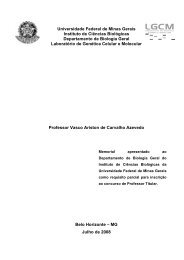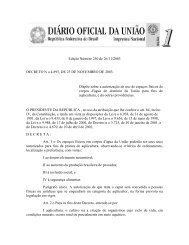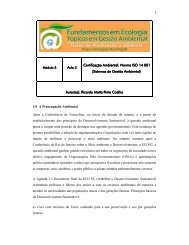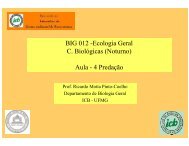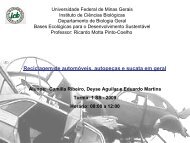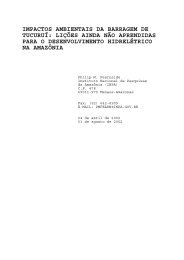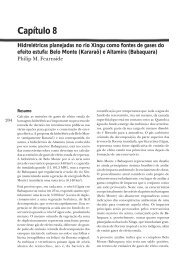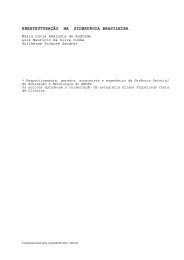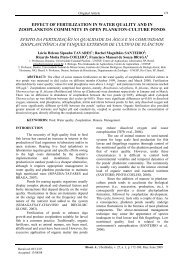guía práctica de experimentos para - Ecologia e Gestão Ambiental
guía práctica de experimentos para - Ecologia e Gestão Ambiental
guía práctica de experimentos para - Ecologia e Gestão Ambiental
You also want an ePaper? Increase the reach of your titles
YUMPU automatically turns print PDFs into web optimized ePapers that Google loves.
6. Con base e los valores <strong>de</strong> la producción<br />
primaria <strong>de</strong>l fitoplancton y el impacto <strong>de</strong><br />
consumo <strong>de</strong>l microzooplancton obtenidos,<br />
discutir la variabilidad esperada a corto<br />
plazo <strong>de</strong> la biomasa <strong>de</strong> fitoplancton in situ.<br />
Integrar la información sobre la pérdida <strong>de</strong><br />
otros procesos pertinentes <strong>de</strong> fitoplancton<br />
en el sistema acuático.<br />
7. Durante este experimento práctico, la<br />
concentración <strong>de</strong> clorofila a fue utilizada<br />
como un proxy <strong>de</strong> la biomasa <strong>de</strong><br />
fitoplancton. No obstante, el análisis<br />
microscópico también pue<strong>de</strong> ser utilizado<br />
<strong>para</strong> cuantificar la abundancia <strong>de</strong><br />
<strong>de</strong>terminados grupos <strong>de</strong> fitoplancton y<br />
protistas fagotróficos en diluciones<br />
diferentes al principio y al final <strong>de</strong> cada<br />
experimento. Discuta las ventajas <strong>de</strong> tener<br />
este tipo <strong>de</strong> información sobre el<br />
tratamiento y la interpretación <strong>de</strong> los datos<br />
mediante <strong>experimentos</strong> <strong>de</strong> dilución.<br />
REFERENCIAS<br />
1. Calbet A. & Landry M. 2004. Phytoplankton<br />
growth, microzooplankton grazing, and carbon<br />
cycling in marine systems. Limnology and<br />
Oceanography 49:51-57.<br />
2. Domingues R.B., Barbosa A.B. 2009. Effects of<br />
nutrient and light enrichment on phytoplankton<br />
growth. In: L. Chícharo, I. Wagner, M. Lapinska<br />
and M Zalewski (eds). Practical Experiments<br />
Gui<strong>de</strong> for Ecohydrology, UNESCO-Bresce,<br />
UAlg, EcoReach, ERCE a/u UNESCO, PAN,<br />
DAE UL..<br />
3. Holmes R.W. 1970. The Secchi disc in turbid<br />
coastal waters. Limnology and Oceanography<br />
15:688-694.<br />
4. Landry M. 1993. Estimating rates of growth and<br />
grazing mortality of phytoplankton by the<br />
dilution method. In: P.F. Kemp, B.F. Sherr, E.B.<br />
Sherr and J.J. Cole. Handbook of Methods in<br />
Aquatic Microbial Ecology. Boca Raton, Lewis<br />
Publishers. 715-722 pp.<br />
5. Landry M.R., Hasset R.P. 1982. Estimating the<br />
grazing impact of marine microzooplankton.<br />
Marine Biology 67:283-288.<br />
6. Parsons T.R., Maita Y., Lalli C.M. 1984. A<br />
Manual of Chemical and Biological Methods for<br />
Seawater Analysis. Pergamon Press.<br />
7. Poole H.H., Atkins W.R.G. 1929. Photoelectric<br />
measurements of submarine illumination<br />
throughout the year. Journal Marine Biological<br />
Association United Kingdom 16:297-325.<br />
8. Zalewski M. 2000. Ecohydrology-the scientific<br />
background to use ecosystem properties as<br />
GUIA DE EXPERIMENTOS PRÁCTICOS PARA ECOHIDROLOGÍA<br />
management tools toward sustainability of<br />
water resources. Guest Editorial in Ecological<br />
Engineering 16:1-8.<br />
ANEXO<br />
Formulas:<br />
ecuación 1 Im = Io.(1-e -Ke.Zm ).(1/ Ke.Zm)<br />
ecuación 2 Ke = 1.7/ Zs<br />
ecuación 3 Ke = 1.4/ Zs<br />
ecuación 4 r i (d -1 ) = (ln Chlt-i – ln Chlo-i)/∆t<br />
ecuación 5 y = ax + b<br />
ecuación 6 ∆ r = r DIL1.0+ – r DIL 1.0<br />
ecuación 7 µ = µo - ∆ r<br />
ecuación 8 PP = (Bo.e µt ) – Bo<br />
ecuación 9<br />
I =100 [(Bo.e µt –Bo)–( Bo.e (µ - g) t – Bo)] /( Bo.e µ t -<br />
Bo)<br />
Leyendas:<br />
Bo – la biomasa <strong>de</strong> fitoplancton inicial en la<br />
muestra <strong>de</strong> agua sin diluir (μgC.L -1 )<br />
Chlo-i – concentración <strong>de</strong> clorofila a en la<br />
dilución i al inicio <strong>de</strong>l experimento (μg.L -1 )<br />
Chlo-i – concentración <strong>de</strong> clorofila a en el la<br />
dilución i al final <strong>de</strong>l experimento (μg.L -1 )<br />
g – tasa <strong>de</strong> consumo <strong>de</strong>l microzooplancton<br />
(unida<strong>de</strong>s: d -1 )<br />
l – Impacto <strong>de</strong>l consumo <strong>de</strong>l microzooplancton<br />
sobre la producción <strong>de</strong> fitoplancton (% <strong>de</strong> la<br />
producción <strong>de</strong> fitoplancton se retira diariamente)<br />
I0 – intensidad <strong>de</strong> luz media en la superficie<br />
(µE.m -2 .s -1 )<br />
Im – intensidad <strong>de</strong> luz media en la superficie <strong>de</strong><br />
mezcla (µE.m -2 .s -1 )<br />
Ke – coeficiente <strong>de</strong> extinción <strong>de</strong> la luz vertical<br />
(m 1 )<br />
PP – la producción <strong>de</strong> fitoplancton en red<br />
(µgC.L -1 .d -1 )<br />
ri – tasa <strong>de</strong> crecimiento aparente <strong>de</strong>l fitoplancton<br />
en la dilución i (d -1 )<br />
r DIL1.0+ – tasa <strong>de</strong> crecimiento aparente <strong>de</strong>l<br />
fitoplancton en muestras <strong>de</strong> agua sin diluir<br />
enriquecida <strong>de</strong> nutrientes (d -1 )<br />
r DIL1.0 –tasa <strong>de</strong> crecimiento aparente <strong>de</strong>l<br />
fitoplancton en muestras <strong>de</strong> agua sin diluir y sin<br />
adiciones <strong>de</strong> nutrientes (d -1 )<br />
t – tiempo (d)<br />
∆t – duración <strong>de</strong> la incubación (d)<br />
µ –tasa <strong>de</strong> crecimiento instantánea in situ <strong>de</strong>l<br />
fitoplancton (d -1 )<br />
µ0 –la tasa <strong>de</strong> crecimiento instantáneo potencial<br />
<strong>de</strong>l fitoplancton (d -1 )<br />
Zm – profundidad <strong>de</strong>l disco <strong>de</strong> Secchi (m)<br />
Zs – profundidad <strong>de</strong> la capa <strong>de</strong> mezcla (m)<br />
50




